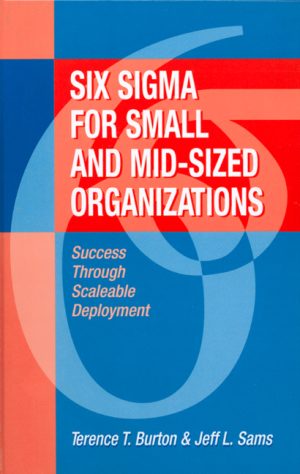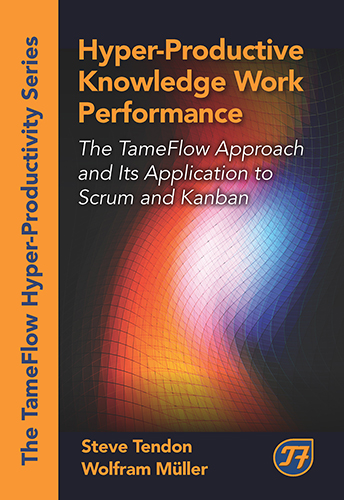Hyper-Productive Knowledge Work Performance
$54.95
The TameFlow Approach and Its Application to Scrum and Kanban
By Steve Tendon and Wolfram Müller
Hardcover, 7×10, 368 pages
ISBN: 978-1-60427-106-5
December 2014
LEARN & EARN: Get 7.6 PDUs in the PMI skill areas of Technical, Leadership, or Strategic and Business Management Skills
Description
By some estimates, knowledge workers outnumber all other workers in North America alone by a four to one margin. Knowledge work and knowledge workers vary with each profession, depending on the industry – from software developers to engineers, architects to pharmaceutical researchers, and so forth. They are usually responsible for exploring and creating ideas, new products, new designs or perhaps new models for doing business to help their organization achieve or maintain a competitive advantage. As much of this type of work is intangible, productivity is a mystery to most business executives, managers and team leaders.
This unique reference shows how to lead knowledge workers, manage knowledge work and build a hyper-productive knowledge work organization, by taming and managing the four flows of organizational performance (psychology, information, work and finance) to produce spectacular operational and financial throughput results.
Inspired by his experience and knowledge gained at Borland International, where a hyper-productive level of performance was achieved resulting in the most productive software project ever documented, author Steve Tendon devised TameFlow. TameFlow is an approach that can be superimposed on any preexisting process, method, and practice to enable performance improvement by several orders of magnitude and a state of hyper-productivity. It is adaptable to nearly every industry, and can be applied to any knowledge work domain or organization that generates business value through knowledge.
TameFlow blends and merges different ideas from a variety of schools of thought. It is founded in pattern theory and organizational performance patterns which are used to analyze and decompose processes, methodologies, and management practices into constituent parts to observe productivity patterns, and then they are recombined in new configurations to enable hyper-productive levels of performance.
In this volume of The TameFlow Hyper-Productivity Series, the TameFlow approach is explained within the context of knowledge work performed in a software development organization. Mr. Tendon teams up with author, Wolfram Müller, a thought-leader and expert in Critical Chain and Advanced Agile Project Management to illustrate its application to Scrum, the most widely used Agile software project management framework, and to Kanban, a method used for knowledge work with an emphasis on just-in-time delivery and change management.
The authors demonstrate how constraints management (TOC) can improve Scrum and Kanban in powerful ways, bringing more predictability of behavior of the system as a whole, as well as to the individuals involved. Their combination becomes a breeding ground for the development of Unity of Purpose and Community of Trust. Both Scrum and Kanban can be extended with features of the TOC, and help create a hyper-productive organization.
Key Features
- Reveals a number of practical methods, models, and tools to manage knowledge work, and discusses what needs to be considered from a managerial and organizational perspective to develop a hyper-productive firm capable of delivering superior performance
- Shows how to shape the information flow between individuals and groups and build an organization’s collective intelligence, setting the foundation for the organization’s culture, values, and principles
- Teaches how to reach a psychological state of flow where individuals or groups achieve high performance levels
- Describes how to master operational flow or the rate at which goods and services are delivered to the marketplace
- Explains how to maximize financial flow or the rate at which products or services are turned into positive cash flow
- Demonstrates, by applying the TameFlow approach, how to overcome typical pitfalls of Scrum and Kanban, and how they can be extended with features of the Theory of Constraints to help create a hyper-productive organization
- WAV™ offers downloadable spreadsheets to support all necessary functions for TameFlow-Scrum—available from the Web Added Value™ Download Resource Center
About the author(s)
Steve Tendon, creator of the TameFlow management approach, is a senior, multilingual, executive management consultant, experienced at leading and directing multinational and distributed knowledge-work organizations. He is an expert in organizational performance transformation programs. Mr. Tendon is a sought-after adviser, coach, mentor and consultant, as well as author and speaker, specializing in organizational productivity, organizational design, process excellence and process innovation. Steve helps businesses create high-performance organizations and teams and holds a MSc. in Software Project Management from the University of Aberdeen.
Mr. Tendon has published numerous articles and is a contributing author to Agility Across Time and Space: Implementing Agile Methods in Global Software Projects. Steve is currently a Director at TameFlow Consulting Ltd, where he helps clients achieve outstanding organizational performance by applying the theories and practices described in this book. Mr. Tendon has held senior Software Engineering Management roles at various firms over the course of his career, including the role of Technical Director for the Italian branch of Borland International, the birthplace of hyper-productivity in software development. Borland’s development of Quattro Pro for Windows remains the most productive software project ever documented. This case was Mr. Tendon’s source of inspiration that led to his development of the TameFlow perspective and management approach.
Wolfram Müller, thought-leader and expert in Critical Chain and Advanced Agile Project Management, is CEO of Speed4Projects, and Director of Sales and Senior Consultant for VISTEM GmbH & Co. KG. Wolfram’s formal education is in Mechatronics and Mechanical Engineering, which he gained from Karlsruhe Institute of Technology (KIT) and Hochschule Karlsruhe – Technik und Wirtschaft in Germany. Early in his career, Wolfram was developer and project manager for BARD/angiomed, and gained first-hand experience in the development and manufacturing of medical devices. At this time, he learned how the tools of the traditional project management work and about their drawbacks. From 2000 to 2010 he worked for 1&1 Internet AG. He began as a developer and later was made Head of their Project Office, and was responsible for more than 500 projects. He used ideas from the Lean, Critical Chain, Theory of Constraints (TOC), and Agile realms to achieve success. Based on this, he developed add-ons to Agile methods to make them compatible with Critical Chain, an approach to project management based on TOC concepts. His focus is always on speed, throughput, reliability and agility. Mr. Müller has published numerous articles, is co-author of the book The CIOs Guide to Breakthrough Project Portfolio Performance, and a professional speaker.
Table of Content
Part I: TameFlow Principles of Hyper-Productive Knowledge Work Management
Chapter 1 – A Case of Software Hyper-Productivity
Chapter 2 – Shapes and Patterns of Hyper-Productivity
Chapter 3 – The Nature of Knowledge Work
Chapter 4 – Management’s Profound Understanding of Knowledge Work
Chapter 5 – Management’s Responsibility and Learning Organization
Chapter 6 – Discovery Driven Planning
Chapter 7 – Budgets Considered Harmful
Chapter 8 – Creating a Shared Vision at the Team Level
Chapter 9 – Critical Roles, Leadership and More
Chapter 10 – The Thinking Processes
Chapter 11 – Throughput Accounting
Chapter 12 – Herbie and Kanban
Chapter 13 – The Financial Metric Supporting Unity of Purpose and Community of Trust
Chapter 14 – The Kanban Method, Flow and Throughput
Chapter 15 – Understanding the Impact of a Constraint
Chapter 16 – The (Super)-Human Side of Flow
Part II: Hyper-Productive Scrum and Kanban Applying the TameFlow Perspective
Chapter 17 – Challenges of Work-State WIP Limits
Chapter 18 – TameFlow-Kanban: The Throughput Focused Kanban
Chapter 19 – Understanding Common Cause Variation
Chapter 20 – Improving While In the Flow
Chapter 21 – Root Cause Analysis the TOC Way
Chapter 22 – In Practice with Scrum
Chapter 23 – Reliable Scrum and Reliable Kanban
Chapter 24 – From Reliable to TameFlow-Scrum
Chapter 25 – From Production to Projects
Reviews
“Reading Hyper-Productive Knowledge Work Performance has influenced my thinking more than any other recent book I have read about how to transform my company’s culture to achieve higher levels of productivity. It’s like the perfect mix of Fred Brooks, W. Edwards Deming, Donald Reinertsen, David Anderson, and Jeff Sutherland all rolled into one approachable and pragmatic book. I recognized a lot of what I already knew and then was pleasantly surprised with how the authors used hyper-productivity to show how it all interconnected. All in all, it is an eye opening book that provides a concrete path to hyper-productivity.”
—Curt Hibbs, Chief Agile Evangelist, Boeing
“A must read for all who want to develop their understanding of productivity in software development and other knowledge worker environments! This book explores the universe of hyper-productive teams and draws a road-map that can help your team evolve to a similar state.”
—Vasco Duarte, Agile Coach
“Hyper-Productive Knowledge Work Performance has become one of my favorite technical books as it clarifies the productive transitioning for Agile software project management environments. I highly congratulate the authors.”
—Etienne Du Plooy, Director, TPACC
“The TameFlow Approach introduced in this book has affected my perspective towards flow. I’m looking forward to trying some of these ideas on one of the enterprise-scale flow systems I’m involved with.”
—Yuval Yeret, Agile Practice Lead, Agilesparks
“…Hyper-Productive Knowledge Work Performance offers beneficial guidelines for any leader in an organization who is seeking improved productivity of software development projects-including Executives, Managers, PMOs, Scrum Teams and Business Partners; and it also shares very good guidelines on how to bridge gaps in communication, processes, finances and behavioral flows in an organization and at a team level.
I learned a great deal from reading this book. Some of the golden nuggets include ways to improve organizational cohesiveness when applying agile principals; and the high level guidance provided on how to build in traditional project management activities (such as best practices on budgeting, communication and productive teams) in an agile environment.”
— Nazanin Mehrooz, Certified Project Manager and Scrum Master. (The full review can be seen in the PM World Journal, July 2015 edition)
Related products
-

Six Sigma for Small and Mid-Sized Organizations
Retail Price: $49.95$44.95 Add to cart -

Handbook for Supply Chain Risk Management
Retail Price: $79.95$69.95 Add to cart -

Advanced Project Portfolio Management and the PMO
Retail Price: $74.95$59.95 Add to cart -

Financially Focused Project Management
Retail Price: $54.95$44.95 Add to cart -

Winning E-Learning Proposals
Retail Price: $64.95$54.95 Add to cart

